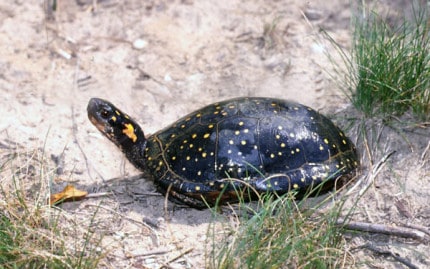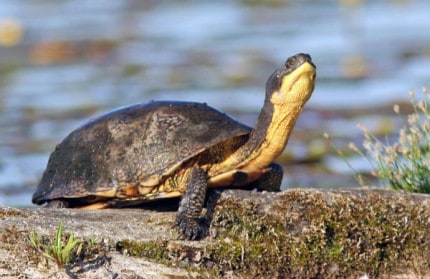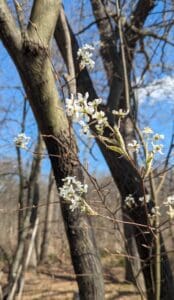
(Chelsea Update would like to thank Tom Hodgson and the Waterloo Natural History Association for the information and photos in this story.)
Most people have never seen the spotted turtle, Michigan’s rarest.
It only survives in isolated populations in a few places in the state. One of those places is located in the Waterloo Recreation Area just west of Chelsea. They are sighted periodically near the Discovery Center and a new hatchling was found along the bog boardwalk several years ago.
This beautiful, diminutive turtle has a maximum shell length of a little over 5 inches. It is named for the bright yellow spots that cover its upper shell. It is not to be confused with the much larger and more common Blanding’s turtle, which can have pale, yellow spots on its upper shell. The Blanding’s turtle also has a bright yellow throat and chin which the spotted turtle lacks.
The primary reasons for the spotted turtle’s decline are loss of habitat and illegal collecting for the pet trade. It is now unlawful to collect or possess a spotted turtle in Michigan. Spotted turtles require small bodies of clean, shallow water with soft or muddy bottoms and some emerging vegetation. These environments are found in the ponds, bogs, fens, marshes and wet meadows still common in the Waterloo Recreation Area.
Spotted turtles are one of the earliest to become active in the spring, emerging soon after the ice and snow melt in March. In early spring, they spend a great deal of time basking on logs, muskrat houses or other objects protruding above the water. During the warm summer months they escape the heat by burying themselves in the mud. Therefore, they are very unlikely to be seen at that time.
Females lay their eggs in June, usually in the evening after the heat of the day. The young hatch in August or September. Most nests succumb to predation from raccoons and skunks. Fortunately once the turtles reach full size they may live over 30 years in the wild. This is why it is so important that these turtles not be collected, as they cannot contribute to the future of their species if they are locked away in someone’s aquarium.
It’s comforting to know that the spotted turtle habitat located in the Waterloo Recreation Area will always be protected.
















So interesting. I always enjoy your posts so much.
I agree with Susan. Thank you for writing these nature stories. Today I heard many frogs along Conway and saw turtles in the pond there. Nice signs of spring.